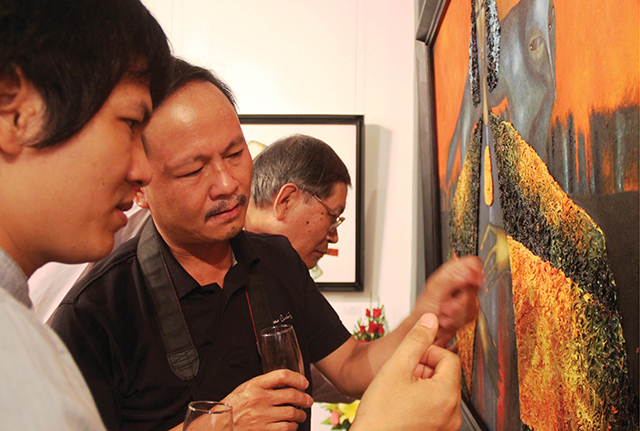
The writer and artist Le Minh Phong (on the left) is presenting his works at his painting exhibition.
In the talk with Thua Thien Hue Weekly in a late year afternoon, he said, “to many others, their personal and artistic worlds do not intertwine, but mine are closely connected, which reflects inner feelings and bears the nuances of my spiritual and practical life”.
Le Minh Phong is known on literary forum as the writer of short stories and novels obsessed by the human fates. Is there a tight bond between your real life and literature?
It is true that my world is sometimes dark, and in this world the characters and their dreams are stuck in hardship, but it is not always that they do not have the way out. You will find underlying those works my messages about heading for light.
Arts should not bring forward the negative energy. On the contrary, the goal of arts is to convey positive messages even when they are manifested in a melancholy mood. To an art practitioner, the sadness they have is sometimes the energetic motivation for them to get ahead to explore the inner corners of the human world.
Despite being well-known as a writer, you have recently turned to painting and sculpture and created works popular with the artist circle. What has led you to this change?
Similar to life, art is considered to be a long flow; and, an aspect of arts cannot fulfil the task to describe it. Each field of arts has its own strength and weakness in its approach to the inner and outer worlds.
While literature tells us stories, painting brings us concepts of life. Many things I cannot express in my literary works can be depicted in my paintings, and vice versa.
Are there many obstacles on your journey to pursue your interests owing to the lack of formal training at the college of arts?
I’m one of the self-trained painters. Previously, many others used to be very successful. At the college, students are better prepared with courses that help building their practical skills, as well as provided with handbooks to explore the artistic world. I actually have certain difficulties without the formal training.
I have spent a very long time exploring the materials and their interaction in order to find out what material and visual-forming method would be best for me. In addition, the access to the fine art market has been a big problem.
Who is most influential in your creativity? And why is it so?
I have learned different ways of behavior in both life and art from other people. Perhaps, I have been most influenced by the writer Jorge Luis Borges.
He was one of the greatest writers of the twentieth century. He had so many things that went beyond my cognition. Jorge was dynamic but secretive and even mysterious. He knew how to remove the barrier and play with dreams.
What do you think about the comment that looking at your painting is like reading your book?
It is, perhaps, a personal point of view, and I respect it. Considering many aspects of arts, however, it is not very convincing as literature and painting are typologically different.
A literary work needs a plot, a system of characters and well-handled narrative techniques to achieve the effectiveness. For a painting, however, if the story and the author’s ideas are centered, it hardly has the internal power.
Sometimes, the admiration of a painting does not necessarily rely entirely on cognition. The effect of admiration simply lies in the silence.
Many of your paintings are interested in even when they are beginning to take shape. How do you feel about this?
It has been my great effort to gain a modest place for my works in the art market. I never gave up although my paintings were hardly bought for the early years in my career.
In my opinion, it is common that an art practitioner is unable to sell one, two or even dozens of his works. But when he has hundreds of, or thousands of paintings, he draws certain attention from the painting collectors.
When a painter has a large number of works, a distinctive language, a creative world of his own, he deserves the public attention to what he has done.
Le Minh Phong (born 1985, from Ha Tinh) earned a BA in Literature from the University of Education, Hue University. He is currently working at Song Huong Magazine. Despite success in literature, he has turned to painting and sculpture in recent years. Apart from participating in exhibitions, he had two exhibitions on his own at the French Institute in Hue, “The Inner” (2015) and “The Successive” (2018). Each exhibition is a manifestation of a different series, expressing the aspiration to touch the minds of modern people. It is a type of consciousness that seems to go beyond all interpretations of the living language.
Thank you very much for the talk.
By PHAN THANH
